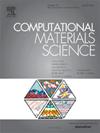Harnessing graph convolutional neural networks for identification of glassy states in metallic glasses
IF 3.1
3区 材料科学
Q2 MATERIALS SCIENCE, MULTIDISCIPLINARY
引用次数: 0
Abstract
Graph Convolutional Neural Networks (GCNNs) have emerged as powerful tools for analyzing materials. In this study, we employ GCNNs to examine structural characteristics of CuZr metallic glasses (MGs) and identify their states. We use molecular dynamics to simulate the quenching process of CuZr, using cooling rates ranging from 10 to 10 K/s to produce six unique glassy states. For each state, we create a dataset comprising 1,800 distinct samples. We evaluate the effectiveness of various GCNNs, including Graph Attention Neural Network (GANN), Graph Sample and AggreGatE (GraphSAGE), Graph Isomorphism Network (GIN), and Relational Graph Convolutional Neural Network (RGCN). GANN and GraphSAGE demonstrate comparable performance, achieving an overall accuracy of 81 % in classifying the MG states. These results underscore the potential of GCNNs to detect subtle structural variances in disordered materials and point to broader application of deep learning in the analysis of MGs and other amorphous substances.利用图卷积神经网络识别金属玻璃中的玻璃态
图卷积神经网络(GCNN)已成为分析材料的强大工具。在本研究中,我们利用图形卷积神经网络来研究 CuZr 金属玻璃 (MG) 的结构特征并确定其状态。我们利用分子动力学模拟了 CuZr 的淬火过程,使用 10 到 10 K/s 的冷却速率产生了六种独特的玻璃态。对于每种状态,我们都创建了一个包含 1,800 个不同样本的数据集。我们评估了各种 GCNN 的有效性,包括图形注意神经网络 (GANN)、图形样本和聚合神经网络 (GraphSAGE)、图形同构网络 (GIN) 和关系图卷积神经网络 (RGCN)。GANN 和 GraphSAGE 的性能相当,对 MG 状态进行分类的总体准确率达到 81%。这些结果凸显了 GCNN 在检测无序材料中细微结构差异方面的潜力,并为深度学习在分析 MG 和其他非晶态物质方面的更广泛应用指明了方向。
本文章由计算机程序翻译,如有差异,请以英文原文为准。
求助全文
约1分钟内获得全文
求助全文
来源期刊

Computational Materials Science
工程技术-材料科学:综合
CiteScore
6.50
自引率
6.10%
发文量
665
审稿时长
26 days
期刊介绍:
The goal of Computational Materials Science is to report on results that provide new or unique insights into, or significantly expand our understanding of, the properties of materials or phenomena associated with their design, synthesis, processing, characterization, and utilization. To be relevant to the journal, the results should be applied or applicable to specific material systems that are discussed within the submission.
 求助内容:
求助内容: 应助结果提醒方式:
应助结果提醒方式:


